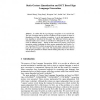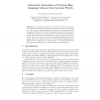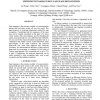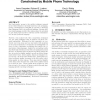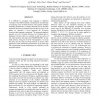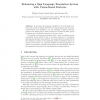ACII
2005
Springer
13 years 10 months ago
2005
Springer
To collect data for sign language recognition is not a trivial task. The lack of training data has become a bottleneck in the research of singer independence and large vocabulary r...
ICMI
2005
Springer
13 years 10 months ago
2005
Springer
Sign language recognition (SLR) plays an important role in human-computer interaction (HCI), especially for the convenient communication between deaf and hearing society. How to e...
GW
2005
Springer
13 years 10 months ago
2005
Springer
Hitherto, one major challenge to sign language recognition is how to develop approaches that scale well with increasing vocabulary size. In large vocabulary speech recognition real...
GW
2005
Springer
13 years 10 months ago
2005
Springer
In Sign Language recognition, one of the problems is to collect enough data. Data collection for both training and testing is a laborious but necessary step. Almost all of the stat...
GW
2005
Springer
13 years 10 months ago
2005
Springer
Abstract. In our paper we present a method for the automatic generation of single German Sign Language glosses from German words. Glosses are often used as a textual description of...
ICIP
2005
IEEE
13 years 10 months ago
2005
IEEE
Sign language is the primary modality of communication among deaf and mute society all over the world. This paper proposes a viewpoint independent method for sign recognition. Con...
ASSETS
2006
ACM
13 years 10 months ago
2006
ACM
For Deaf people, access to the mobile telephone network in the United States is currently limited to text messaging, forcing communication in English as opposed to American Sign L...
ASSETS
2006
ACM
13 years 10 months ago
2006
ACM
CopyCat is an American Sign Language (ASL) game, which uses gesture recognition technology to help young deaf children practice ASL skills. We describe a brief history of the game...
ICMCS
2006
IEEE
13 years 10 months ago
2006
IEEE
It is difficult to recognize sign language in different viewpoint. The HMM method is hindered by the difficulty of extracting view invariant features. The general template matchin...
GW
2007
Springer
13 years 10 months ago
2007
Springer
Abstract. In automatic sign language translation, one of the main problems is the usage of spatial information in sign language and its proper representation and translation, e.g. ...
